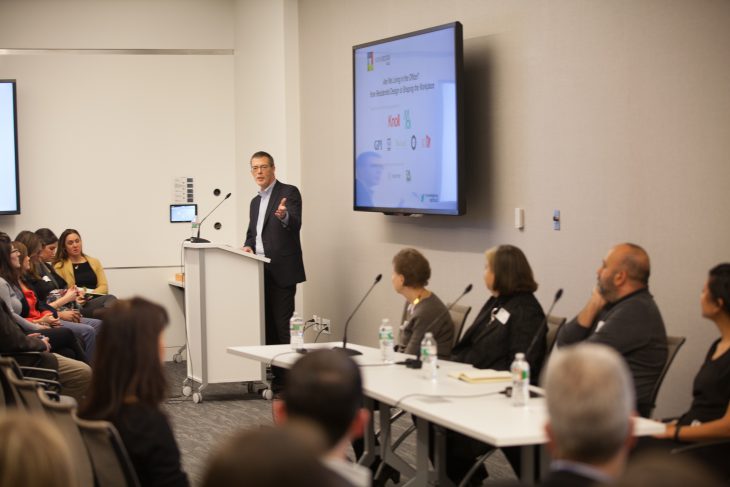We talked about open offices, emotional ergonomics, and more at last week’s Work Design TALK in Tysons Corner. Catch the highlights below.

We gathered a sold-out crowd of nearly 120 design-minds on Thursday at Convene to talk shop about the blurred lines between work and home. Is it a good thing? Is it related to the open office vs. cubes debate? Does mobility have something to do with it? We took to our panel—Kamran Arshad, principal designer at Coalesse; Ruth Jansson, principal and director of interiors at Leo A Daly; Barbara Mullenex, principal at Perkins Eastman; and Janey Saunders, business development at Knoll—to find out.

“I don’t think there should be this hard line between ‘this is your life’ and ‘this is your work’,” said Arshad. “It should co-mingle.”
He offered the lobby of the Ace Hotel as an example of a workspace (that’s not really a workplace) that gets it right. “It’s lovely,” he said. “The application is not that different from a workstation. There’s a long farm table with power underneath, and café chairs.” He noted that while café chairs may not be the most ergonomically-conscious solution, any physical discomfort is tempered by the “feel” of the space. He calls this “emotional ergonomics”.

“Comfort has to do with the vibe and culture, too,” he said. “You need it.” He added that while farm tables and good vibes may not be the first things you think of when you think of a suitable workstation, for most people, it works.
Jansson suggested that workspaces with a residential feel might help to combat office distractions. “If residential cues were integrated properly, you could escape” distractions and have more places to regroup, she said. Sort of like repairing to your bedroom after hosting a party in your living room. But maybe that’s the same as returning to your spacious private office after an intense meeting in a conference room?

So, wait: If we all agree that there are (and should continue to be) more residential moves integrated into workspaces, does that mean we’re advocating for going back to closed offices?
Mullenex drew laughter from the crowd when she admitted that “the idea of working in an office with a door terrifies” her. “What do people do in there?!”

“At the end of the day, choice stands out as the most important thing,” said Bob Fox, who moderated the TALK. “We know completely closed off and sterile won’t work for most businesses. But we know completely open doesn’t work, either. So what kind of choices do we need to be integrating into the workplace?”
Mullenex indicated that even switching between her regular task chair and a Steelcase Buoy keeps her sharp during the day. “Materiality is really important, too,” she said. “There’s a perception about materiality in the corporate world, that it’s so different from the textures we expect in daily life.”

Arshad pointed out that the outcome of strides in digital communication is that now people are able to do work outside of the office, both at home and in third places. “So workspaces need to start being inspiring places, like the home,” he said. “We’ve got to change the mind frame that workspace has to be antiseptic to be professional. It’s not a playground, either; there’s a very sophisticated center.”
“Why do people come to the office in the first place?,” Saunders asked in closing remarks. “People want a sense of community. We need to bring the togetherness back into the sterile office.”
A special thanks to our sponsors for making the TALK possible:
Knoll
MOI
Masland Contract
Division 9 Associates
Convene
GPI
ASID
Coalesse
FOX Architects


